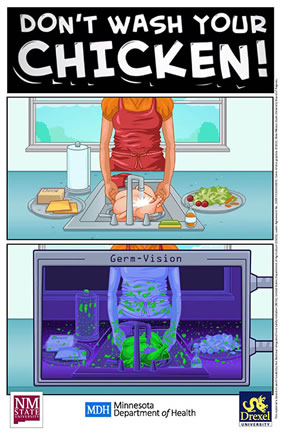Don’t Wash That Chicken!
go.ncsu.edu/readext?582963
en Español / em Português
El inglés es el idioma de control de esta página. En la medida en que haya algún conflicto entre la traducción al inglés y la traducción, el inglés prevalece.
Al hacer clic en el enlace de traducción se activa un servicio de traducción gratuito para convertir la página al español. Al igual que con cualquier traducción por Internet, la conversión no es sensible al contexto y puede que no traduzca el texto en su significado original. NC State Extension no garantiza la exactitud del texto traducido. Por favor, tenga en cuenta que algunas aplicaciones y/o servicios pueden no funcionar como se espera cuando se traducen.
Português
Inglês é o idioma de controle desta página. Na medida que haja algum conflito entre o texto original em Inglês e a tradução, o Inglês prevalece.
Ao clicar no link de tradução, um serviço gratuito de tradução será ativado para converter a página para o Português. Como em qualquer tradução pela internet, a conversão não é sensivel ao contexto e pode não ocorrer a tradução para o significado orginal. O serviço de Extensão da Carolina do Norte (NC State Extension) não garante a exatidão do texto traduzido. Por favor, observe que algumas funções ou serviços podem não funcionar como esperado após a tradução.
English
English is the controlling language of this page. To the extent there is any conflict between the English text and the translation, English controls.
Clicking on the translation link activates a free translation service to convert the page to Spanish. As with any Internet translation, the conversion is not context-sensitive and may not translate the text to its original meaning. NC State Extension does not guarantee the accuracy of the translated text. Please note that some applications and/or services may not function as expected when translated.
Collapse ▲Participants at our recent Cooking for Crowds class were shocked when we told them that the best practice is not to wash chicken before cooking. I know lots of recipes start with rinse and pat the chicken dry. But don’t do it!
If you have that habit, you’re not alone. Research shows that 70% of consumers
wash their chicken before they cook it. What do you do?
Why do people wash chicken in the first place? Possibly because they think it will remove some dangerous bacteria. Yes, raw poultry sold in the United States is often contaminated with Campylobacter, Salmonella or some other bacteria.
Poultry is the fourth most common food associated with foodborne illness
accounting for 22% of all foodborne illnesses and 29% of all foodborne illness
related deaths.
If you wash the poultry to try to wash these bacteria off, don’t bother, it doesn’t
work. Research by the British Food Standards Agency between showed that
rinsing off whole poultry, or beef for that matter, does not remove all of the
bacteria from the surface of the meat.
By washing poultry, you may actually be causing more problems. Researchers
looked at what happens when people rinse their raw meat and found that the
only thing this did was increase the chance of contamination of the cook’s hands
and nearby surfaces. The rinsing or washing could splatter bacteria all over the
sink, the countertop and anything else in the area. It’s estimated that this splatter
can spread as far as three feet. This is called cross-contamination. Think about other foods that might be on that countertop, chances are high that some of the
foods in the “splash zone” won’t be cooked and would become contaminated
with the raw poultry juice.
So what’s the best thing to do instead of washing the meat? Wash your hands
before you begin. Carefully remove and discard wrapping from chicken or turkey.
Try to keep the raw meat, juices, and packaging separated from other foods at all
times. If juices come in contact with kitchen surfaces, wash the counter tops and sinks with hot, soapy water. For extra protection, surfaces may be sanitized with a solution of one tablespoon of unscented, liquid chlorine bleach per gallon of water. Be sure to let those areas dry thoroughly. If you’re still not sure about this and want get excess blood or liquid off the chicken, use a clean paper towel to blot the surfaces, but be careful not to spread juices and throw away the paper towel.
The only way to destroy bacteria on poultry is to cook it to a safe minimum
internal temperature of 165 °F as measured with a food thermometer.
I know habits and practices are hard to break, but this is one you might want to
rethink.
Sources: USDA Meat and Poultry Hotline (1-888-MPHotline)
Cheryle Jones Syracuse
Family and Consumer Science Staff
N.C. Cooperative Extension, Brunswick County Center
Syracuse is a Family and Consumer Science staff member and can be reached at
N.C. Cooperative Extension, Brunswick County Center at 910-253-2610.




